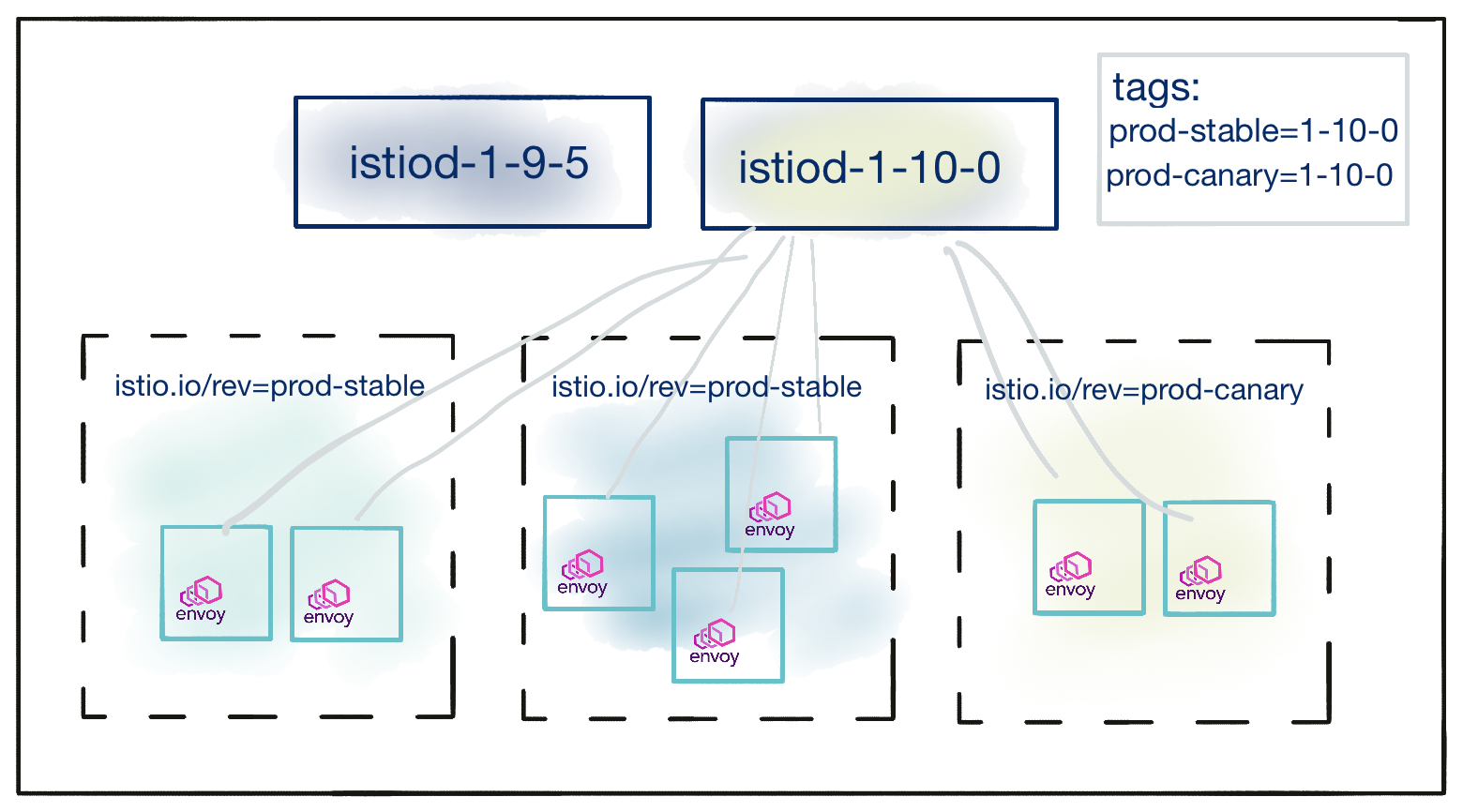Upgrade with Helm
Follow this guide to upgrade and configure an Istio mesh using Helm for in-depth evaluation. This guide assumes you have already performed an installation with Helm for a previous minor or patch version of Istio.
The Helm charts used in this guide are the same underlying charts used when installing Istio via Istioctl or the Operator.
This feature is currently considered alpha.
Prerequisites
Perform any necessary platform-specific setup.
Check the Requirements for Pods and Services.
Install a Helm client with a version higher than 3.1.1.
The commands in this guide use the Helm charts that are included in the Istio release package located at manifests/charts.
Upgrade steps
Change directory to the root of the release package and then follow the instructions below.
Before upgrading Istio, it is recommended to run the istioctl x precheck command to make sure the upgrade is compatible with your environment.
$ istioctl x precheck
✔ No issues found when checking the cluster. Istio is safe to install or upgrade!
To get started, check out https://istio.io/latest/docs/setup/getting-started/
Create a backup
Before upgrading Istio in your cluster, we recommend creating a backup of your custom configurations, and restoring it from backup if necessary:
$ kubectl get istio-io --all-namespaces -oyaml > "$HOME"/istio_resource_backup.yaml
You can restore your custom configuration like this:
$ kubectl apply -f "$HOME"/istio_resource_backup.yaml
Canary upgrade (recommended)
You can install a canary version of Istio control plane to validate that the new version is compatible with your existing configuration and data plane using the steps below:
Upgrade the Kubernetes custom resource definitions (CRDs):
$ kubectl apply -f manifests/charts/base/crdsInstall a canary version of the Istio discovery chart by setting the revision value:
$ helm install istiod-canary manifests/charts/istio-control/istio-discovery \ --set revision=canary \ -n istio-systemVerify that you have two versions of
istiodinstalled in your cluster:$ kubectl get pods -l app=istiod -L istio.io/rev -n istio-system NAME READY STATUS RESTARTS AGE REV istiod-5649c48ddc-dlkh8 1/1 Running 0 71m default istiod-canary-9cc9fd96f-jpc7n 1/1 Running 0 34m canaryFollow the steps here to test or migrate existing workloads to use the canary control plane.
Once you have verified and migrated your workloads to use the canary control plane, you can uninstall your old control plane:
$ helm delete istiod -n istio-systemUpgrade the Istio base chart:
$ helm upgrade istio-base manifests/charts/base -n istio-system --skip-crds
Stable revision labels (experimental)
Manually relabeling namespaces when moving them to a new revision can be tedious and error-prone. Revision tags solve this problem. Revision tags are stable identifiers that point to revisions and can be used to avoid relabeling namespaces. Rather than relabeling the namespace, a mesh operator can simply change the tag to point to a new revision. All namespaces labeled with that tag will be updated at the same time.Usage
Consider a cluster with two revisions installed,1-9-5 and 1-10-0. The cluster operator creates a revision tag prod-stable,
pointed at the older, stable 1-9-5 version, and a revision tag prod-canary pointed at the newer 1-10-0 revision. That
state could be reached via these commands:$ helm template istiod manifests/charts/istio-control/istio-discovery -s templates/revision-tags.yaml --set revisionTags={prod-stable} --set revision=1-9-5 -n istio-system | kubectl apply -f -
$ helm template istiod manifests/charts/istio-control/istio-discovery -s templates/revision-tags.yaml --set revisionTags={prod-canary} --set revision=1-10-0 -n istio-system | kubectl apply -f -
The resulting mapping between revisions, tags, and namespaces is as shown below:
The cluster operator can view this mapping in addition to tagged namespaces through the istioctl tag list command:
$ istioctl tag list
TAG REVISION NAMESPACES
prod-canary 1-10-0 ...
prod-stable 1-9-5 ...
After the cluster operator is satisfied with the stability of the control plane tagged with prod-canary, namespaces labeled
istio.io/rev=prod-stable can be updated with one action by modifying the prod-stable revision tag to point to the newer
1-10-0 revision.
$ helm template istiod manifests/charts/istio-control/istio-discovery -s templates/revision-tags.yaml --set revisionTags={prod-stable} --set revision=1-10-0 -n istio-system | kubectl apply -f -
Now, the situation is as below:
Restarting injected workloads in the namespaces marked prod-stable will now result in those workloads using the 1-10-0
control plane. Notice that no namespace relabeling was required to migrate workloads to the new revision.
Default tag
The revision pointed to by the tag default is considered the default revision and has additional semantic meaning.
The default revision will inject sidecars for the istio-injection=enabled namespace selector and sidecar.istio.io/inject=true object
selector in addition to the istio.io/rev=default selectors. This makes it possible to migrate from using non-revisioned Istio to using
a revision entirely without relabeling namespaces. To make a revision 1-10-0 the default, run:
$ helm template istiod manifests/charts/istio-control/istio-discovery -s templates/revision-tags.yaml --set revisionTags={default} --set revision=1-10-0 -n istio-system | kubectl apply -f -
default tag alongside an existing non-revisioned Istio installation it is recommended to remove the old
MutatingWebhookConfiguration (typically called istio-sidecar-injector) to avoid having both the older and newer control
planes attempt injection.In place upgrade
You can perform an in place upgrade of Istio in your cluster using the Helm upgrade workflow.
Upgrade the Kubernetes custom resource definitions (CRDs):
$ kubectl apply -f manifests/charts/base/crdsUpgrade the Istio base chart:
$ helm upgrade istio-base manifests/charts/base -n istio-system --skip-crdsUpgrade the Istio discovery chart:
$ helm upgrade istiod manifests/charts/istio-control/istio-discovery \ -n istio-system(Optional) Upgrade the Istio ingress or egress gateway charts if installed in your cluster:
$ helm upgrade istio-ingress manifests/charts/gateways/istio-ingress \ -n istio-system $ helm upgrade istio-egress manifests/charts/gateways/istio-egress \ -n istio-system
Uninstall
Please refer to the uninstall section in our Helm install guide.

